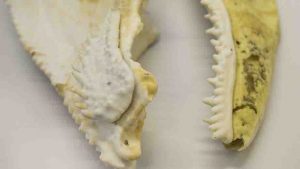
A new study from ANU on a 400 million year old fish fossil has found a jaw structure that is part of the evolutionary lineage linked to humans.
The fossil comes from ancient limestones around Lake Burrinjuck, 50 kilometres northwest of Canberra. The area is rich in fossil shells and corals, but also home to the rare skulls of extinct armoured fish called placoderms.
Co-researcher, ANU PhD scholar Yuzhi Hu, said this example was the best preserved skull and braincase of a placoderm ever found.
“The fossil reveals, in intricate detail, the jaw structure of this ancient fish, which is part of the evolutionary lineage that ultimately led to humans,” said Ms Hu from the ANU Research School of Earth Sciences.
“The jaw joint in this ancient fish is still in the human skull, but is now part of the middle ear.”
The team used high-resolution CT scanning facilities at ANU to investigate the internal structure of the skull and braincase and produced high-resolution 3-D printouts to reassemble the jaw elements – a technique never previously used for fossil vertebrates.
Ms Hu analysed the CT scanning data to reveal a complete set of internal jaw cartilages for the first time in any placoderm, with structures surrounding the jaw joint different to all previous interpretations.
“The amazing preservation of the fossil allows us to trace the grooves carrying the blood supply to the jaws and brain,” she said.
Co-researcher Dr Gavin Young, from Department of Applied Mathematics within the ANU Research School of Physics and Engineering, said the direction of blood flow can be worked out for some major arteries.
“The carotid arteries in humans and other mammals bring blood through the neck to supply the head with oxygen,” he said.
“The intersection of grooves on the floor of the braincase in the Burrinjuck fossil shows the blood was flowing in the opposite direction in the equivalent of the external carotid artery, which supplies blood to the jaw and face in humans.
“This was the main oxygenated blood supply to the internal carotid artery, which forms a distinct groove leading to an opening where it entered the brain cavity.”
The extinct placoderms have been traditionally regarded as an evolutionary side branch, until the recent discovery of Chinese maxillate placoderms, a fossil group researched in Beijing by co-author Dr Jing Lu before she came to ANU.
“The maxilla is the bone forming the upper jaw in humans,” said Dr Lu from the Department of Applied Mathematics within the ANU Research School of Physics and Engineering.
“The Chinese fish fossils have this bone, demonstrating a much closer relationship to human ancestry than previously thought. But other internal structures were apparently made of cartilage, and are not clearly preserved, unlike the Burrinjuck skull.”
Dr Lu said very few fossils preserved such intricate details to allow the reconstruction of extinct animals.
“The Australian fossil helps us to interpret these aspects in the Chinese maxillate placoderms,” she said.
“Thanks to the international collaboration, we are making great progress to work out the sequence of key evolutionary innovations at the origin of the jawed vertebrates.”
The paper is published in Scientific Reports.
Reference:
Yuzhi Hu et al. New findings in a 400 million-year-old Devonian placoderm shed light on jaw structure and function in basal gnathostomes, Scientific Reports (2017). DOI: 10.1038/s41598-017-07674-y
Note: The above post is reprinted from materials provided by Australian National University.










